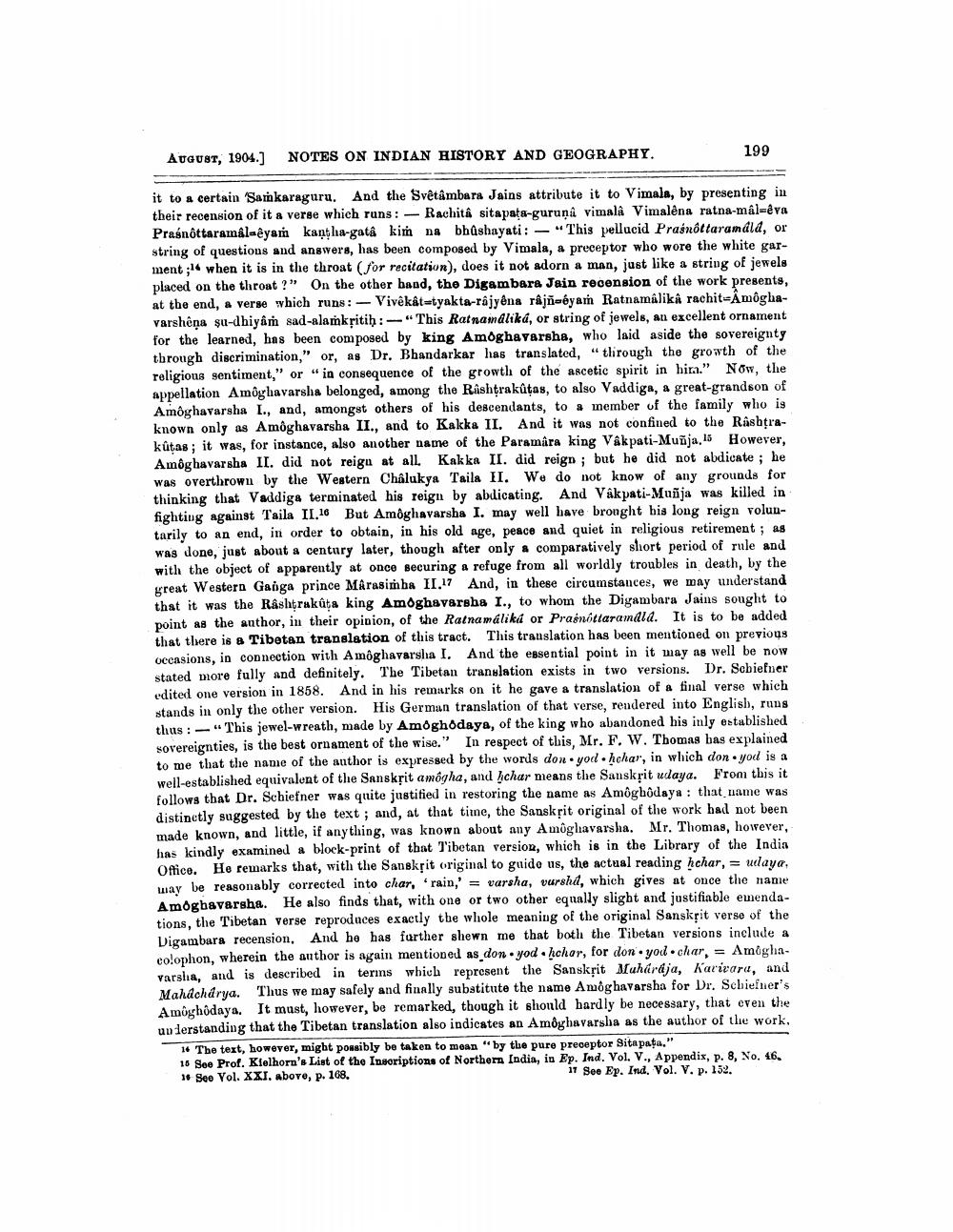________________
AUGUST, 1904.) NOTES ON INDIAN HISTORY AND GEOGRAPHY.
199
it to a certain Samkaraguru. And the Svêtâmbara Jains attribute it to Vimala, by presenting in their recension of it a verse which runs: - Rachita sitapata-guruņa vimalâ Vimalêna ratna-mal-êva Prasnottaramálaêyam kantha-gatâ kim na bhushayati: - This pellucid Praśnóttaranáld, or string of questions and answers, has been composed by Vimala, a preceptor who wore the white garment;14 when it is in the throat for recitation), does it not adorn a man, just like a string of jewels placed on the throat ?” On the other hand, the Digambara Jain recension of the work presents, at the end, a verse which runs: - Vivekâtætyakta-rajyêna râjs-éyam Ratnamalika rachit-Âmôghavarshēna şu-dhiyam sad-alamkritih :-"This Ratnamdliká, or string of jewels, an excellent ornament for the learned, has been composed by king Amoghavarsha, who laid aside the sovereignty through discrimination," or, as Dr. Bhandarkar has translated, "through the growth of the religious sentiment," or " in consequence of the growth of the ascetic spirit in hira." Now, the appellation Amôglavarsha belonged, among the Rashtrakůțas, to also Vaddige, a great-grandson of Amôghavarsha I., and, amongst others of his descendants, to a member of the family who is known only as Amôghavarsha II., and to Kakka II. And it was not confined to the Rashtrakutas; it was, for instance, also another name of the Paramara king Vakpati-Muñja, 15 However, Amôghavarsha II. did not reign at all. Kakka II. did reign ; but he did not abdicate ; he was overthrown by the Western Châlukya Taila II. We do not know of any grounds for thinking that Vaddiga terminated his reign by abdicating. And Vakpati-Muñja was killed in fighting against Taila II.16 But Amoghavarsha I. may well have brought his long reign voluutarily to an end, in order to obtain, in his old age, peace and quiet in religious retirement; as was done, just about a century later, though after only a comparatively short period of rule and with the object of apparently at once securing a refuge from all worldly troubles in death, by the great Western Ganga prince MArasimha II.17 And, in these circumstances, we may understand that it was the Rashtrakûta king Amoghavarsha I., to whom the Digambara Jains sought to point as the anthor, in their opinion, of the Ratnamalikd or Prainottaramdia. It is to be added that there is a Tibetan translation of this tract. This translation has been mentioned on previous occasions, in connection with Amoghavarsha I. And the essential point in it may as well be now stated more fully and definitely. The Tibetan translation exists in two versions. Dr. Scbiefner edited one version in 1858. And in his remarks on it he gave a translation of a final verse which stands in only the other version. His German translation of that verse, rendered into English, runs thus: -" This jewel-wreath, made by Amoghodaya, of the king who abandoned his inly established sovereignties, is the best ornament of the wise." In respect of this, Mr. F. W. Thomas bas explained to me that the name of the author is expressed by the words donyodhchar, in which don yod is a well-established equivalent of the Sanskrit amôgha, and hchar means the Sanskrit udaya. From this it follows that Dr. Schief'ner was quite justified in restoring the name as Amoghodaya : that name was distinctly suggested by the text; and, at that time, the Sanskpit original of the work had not been made known, and little, if anything, was known about any Amûglavarsha. Mr. Thomas, however, has kindly examined a block-print of that Tibetan version, which is in the Library of the India Office. He remarks that, with the Sanskrit original to guide us, the actual reading hchar, = udaya, may be reasonably corrected into char. "rain,' = varsha, vursha, which gives at once the name Amoghavarsha. He also finds that, with one or two other equally slight and justifiable emendations, the Tibetan verse reproduces exactly the whole meaning of the original Sanskrit verse of the Digambara recension. And he has further shewn me that both the Tibetan versions include a colophon, wherein the author is again mentioned as donyodhchar, for donyod.char, = Amoghavarsha, and is described in terms which represent the Sansksit Maharaja, Karivara, and Mahacharya. Thus we may safely and finally substitute the name Amoghavarsha for Dr. Schiefner's Amoghodaya. It must, however, be remarked, though it should hardly be necessary, that even the understanding that the Tibetan translation also indicates an Amôghavarsha as the author of the work,
16 The text, however, might possibly be taken to mean "by the pure preceptor Sitapata." 10 Soo Prof. Klelhorn's List of the Insoriptions of Northern India, in Ep. Ind. Vol. V., Appendix, p. 8, No. 16. 36 See Yol. XXI. above, p. 168.
17 See Ep. Ind. Vol. V. p. 152.




